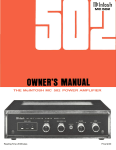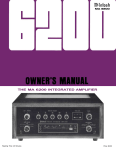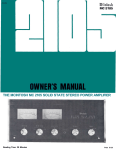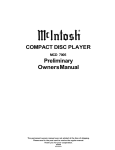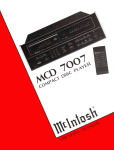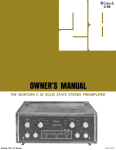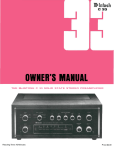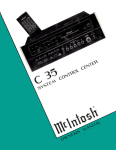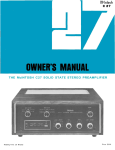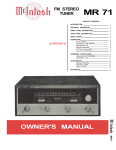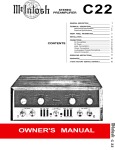Download McIntosh MC2505 Specifications
Transcript
SOLID
STATE
STEREO
POWER AMPLIFIER
MC2505
MC25O5
PRICE $1.25
MC2505
TECHNICAL DESCRIPTION
LOCKING METERS
P E R F O R M A N C E CHARTS
2
2,3
4
5,6
CHARTS
8
SPECIFICATIONS
9
IN A HURRY
10
INSTALLATION
11
TYPICAL HOOKUP
12
CONNECTING
13
BLOCK DIAGRAM
14
OPERATING
15
GUARANTEE
16
The Mclntosh "will to perfection" requires that we probe
constantly into the unknown to bring the performance of our
electronic equipment closer to perfection than ever before.
This requires a constant and relentless search for low noise,
broad band conservative design with an ever lower distortion
factor. This is not required of ordinary equipment of average
designs. It is, for us, a costly but worthwhile scientific and
engineering effort. Our continuing research benefits our customers with the almost complete lack of obsolescence and
the most reliable equipment ever made. It also means the
lowest long-range cost to you. Nearly all of the Mclntosh
equipment ever made is still useable, or in use, though it
may have been made twenty years ago.
MC25O5
Your purchase of a Mclntosh instrument
shows that you are a careful discriminating buyer. One who is interested in quality
performance, quality engineering, quality
manufacturing, and long trouble-free
equipment life. You can protect your investment by spending a few minutes reading this owner's manual.
When you bought a Mclntosh, you bought
countless hours of musical pleasure and
superior performance. Enjoy it!
1
SOLID
STATE
GENERAL DESCRIPTION
STEREO
POWER AMPLIFIER
CONTENTS
GENERAL DESCRIPTION
TECHNICAL DESCRIPTION
The dramatic difference in the quality of music reproduced through
A two stage preamplifier with three transistors in each channel
a Mclntosh instrument is due to low distortion. The distortion of your
increases the input voltage 16 dB.
MC2505 is guaranteed to be less than 0.25% at any frequency from
20 Hz to 20 kHz with both channels operating at 50 watts RMS.
Distortion is measured at full rated power output with both channels
operating. At less than rated power, distortion becomes so small it
can be measured only by the most sophisticated laboratory instruments. Only Mclntosh gives you this kind of performance.
There are 13 transistors in each power amplifier section. The two
stage preamplifier is fed to a pair of matched transistors arranged
as an emitter coupled amplifier with two inputs and one output.
The signal from the preamplifier section connects to one of these
inputs. Both AC and DC negative feedback are applied to the other
input. This large quantity of feedback is used to reduce noise and
Your MC2505 passed more than 75 tests before it was ready for
distortion. The signal is then fed to a voltage amplifier. The volt-
you. Each connection, wire, resistor, capacitor is checked and re-
age amplifier is followed by two driver transistors.
checked. All specifications are checked. Mclntosh testing takes time.
The extra investment in thorough testing assures you of greater
musical enjoyment.
The performance of your Mclntosh MC2505 is backed by a money
The output section is arranged as a series push-pull amplifier.
The power transistors used in the output section of your MC2505
are selected for their high power dissipation capability, wide
frequency response, and large "safe operating area." In addition,
back guarantee. Only Mclntosh gives you a money back guarantee
each power transistor is given four separate tests before it is put
of performance. Your MC2505 must be capable of meeting its pub-
in your MC 2505. This additional testing makes sure your MC 2505
lished specifications or you get a refund of your purchase price.
will deliver its rated power from 20 to 20 kHz with low distortion
Mclntosh promises performance. We either meet our promise or you
and complete reliability.
get your money back.
The power transistors are mounted on oversized anodized heat
Your MC2505 can be protected by a free three year factory service
sinks. The heat sinks assure that under normal operation the
contract. Take advantage of this service. Fill in the application card
transistors will operate at a low temperature. If temperatures in-
found in the owner's packet. The free three year factory service
crease due to a shorted speaker, or restricted ventilation, an auto-
contract covers parts and labor. If anything goes wrong just bring
matic temperature sensing device turns off the MC2505. The
your MC2505 to a factory service station, or return your MC2505
device operates automatically at a preset temperature. The MC
to Mclntosh. All parts and labor necessary to repair your MC2505
2505 will turn on again when the temperature has returned to
will be supplied free of charge. Fill in the service contract applica-
normal limits. This additional feature gives your MC2505 com-
tion found in the owner's packet now.
plete reliability under the most extreme operating conditions.
2
The output stages are matched to the load by the Mclntosh autoformer. The Mclntosh autoformer is carefully wound using Mclntosh trifilar winding and interleaving techniques. Trifilar winding
and interleaving gives the transformers exceptional bandwidth.
The autoformers properly match the power transistors to 4, 8, and
16 ohm loads at all audio frequencies.
The use of the Mclntosh designed trifilar autoformer makes the
Mclntosh solid state amplifiers the only amplifiers that deliver
FULL POWER AT ALL SPEAKER IMPEDANCES. You have not
been power penalized for your choice of loudspeakers when using
the Mclntosh MC2505.
Another of the advantages of the autoformers is the 25 volt output
for a constant voltage distribution system. With the MC2505 several sets of speakers can be operated independently throughout
your home.
To further insure reliability a special power output SENTRY MONI-
POWER SUPPLY SECTION
There are three separate power supply sections. One positive and
TORING CIRCUIT prevents failure of the power output transistors
one negative high current supply is used for the output stages.
due to excessive mismatch of the output. When your MC2505
The other positive supply is used for the driving amplifier stages.
operates normally the SENTRY MONITORING CIRCUIT has no
All supplies are full wave and use silicon rectifiers. Adequate filter-
effect on signals passing through the power amplifier. If the
ing is used to assure an absolute minimum of hum. The power out-
power dissipation should rise above normal operation, the SEN-
put stage filter capacitors have very high capacity, which allows
TRY MONITORING CIRCUIT restricts the drive to the output
full power output below 20 Hz. The power transformer is generous
transistors. The SENTRY MONITORING CIRCUIT acts instantane-
in size and runs cool, even under heavy use.
ously for any input signal or load combination. This arrangement
assures complete circuit reliability. Only Mclntosh gives you this
degree of protection.
3
D Y N A M I C PEAK
LOCKING METERS
With the aid of the CBS test record STR100, the
frequency response of your phono cartridge can
be measured. The graph on page 5 shows the
ideal RIAA curve using the CBS record STR100.
Ordinary meters lack the capability of indicating
the short interval power in a sound wave. The
mass of the meter movement is too great to respond to instantaneous changes in music program material. Mclntosh superior engineering
has developed new circuitry that permits the
meters on the MC2505 to respond to the short
interval power in a sound wave to an accuracy of
98% of the true value. This is another Mclntosh
Follow these steps to plot the performance of
your phonograph cartridge.
1. Set the "METER RANGE SWITCH" to the
—20 position.
2. Play the 1000 Hz test tone recorded on
the CBS Test Record STR100 on your
phonograph.
3. Turn the "LEFT GAIN" control until the
left meter indicates "0."
development that represents a major step forward in the use of power level meters.
There are two circuits that give these meters
the indicating capability of the short interval
power in a sound wave. The first circuit is an
accelerating circuit that compensates for the
inertia characteristics of the meter movement.
Because the short interval power fluctuation is
so rapid, the eye might not perceive the instantaneous power reading. This caused the development of the second circuit, which is a "time
stretching" circuit. The time stretching circuit
delays the movement of the meter needle at
peak reading for a few milliseconds.
•1
4. Turn the "RIGHT GAIN" control until the
right meter indicates "O."
5. Write down the meter indication at each
frequency as the record plays.
6. Transfer the readings by frequency to
the graph.
7. The graph shows the ideal RIAA response curve using the CBS #STR100 test
record. Compare your curve with the curve
on the graph. A deviation of 3 dB from the
ideal is acceptable. By making this check
at regular intervals, (for instance, every 6
months) any deterioration in the cartridge
or system will be quickly detected.
A tape recorder can be checked in the same
fashion.
1. Use a standard frequency response tape
as the signal source.
2. Complete all steps outlined for phono
cartridges.
3. You now have a graph of the playback
characteristics of your tape recorder.
To find the record characteristics of the tape
recorder follow this procedure:
1. Record the CBS Test Record #STR100
on your tape recorder. Adjust the record
volume only on the 1000 Hz signal for
proper recording level. DO NOT ADJUST
THE RECORD VOLUME CONTROL DURING THE RECORDING.
2. Play back the tape just recorded. Complete all steps outlined for tape playback
characteristics.
3. A comparison of the two curves will give
the recording characteristics of your tape
recorder. A deviation of 3 dB is acceptable.
Similar checks can be made on all program
sources in your stereo system. Follow the same
general procedure for any program source for
which a standard reference is available.
20
20
FREQUENCY IN Hz
1k
100
FREQUENCY IN Hz
1k
IDEAL RIAA SYSTEM RESPONSE USING CBS STR 100 TEST RECORD
100
IDEAL RIAA SYSTEM RESPONSE USING CBS STR 100 TEST RECORD
10k
10k
0
2
4
-20
-20
-18
-16
-14
12
-10
-8
-6
-4
-2
20k
20k
-13
-16
14
-12
-10
-8
-6
-4
-2
0
2
4
R E L A T I V E OUTPUT LEVEL IN dB
RELATIVE OUTPUT LEVEL IN dB
5
6
20
20
FREQUENCY IN Hz
1k
100
FREQUENCY IN Hz
1k
IDEAL RIAA SYSTEM RESPONSE USING CBS STR 100 TEST RECORD
100
IDEAL RIAA SYSTEM RESPONSE USING CBS STR 100 TEST RECORD
100k
10k
20k
0
2
4
-20
-20
-18
-16
-14
-12
-10
-8
-6
-4
-2
20k
-18
-16
-14
-12
-10
-8
-6
-4
-2
0
2
4
RELATIVE OUTPUT LEVEL IN dB
RELATIVE OUTPUT LEVEL IN dB
7
TYPICAL PERFORMANCE DATA
POWER OUTPUT vs FREQUENCY
70
POWER OUTPUT RMS WATTS
60
50
40
30
20
10
0
10
100
1k
10k
100k
FREQUENCY IN HERTZ
INTERMODULATION DISTORTION vs POWER OUTPUT
PERCENTAGE INTERMODULATION DISTORTION
PERCENTAGE HARMONIC DISTORTION
HARMONIC DISTORTION vs POWER OUTPUT
0.6
0.5
0.4
0.3
0.2
0.1
100
10
POWER OUTPUT IN RMS WATTS
8
20 Hz
2kHz
20kHz
0.6
0.5
0.4
0.3
0.2
0.1
10
POWER OUTPUT IN EQUIVALENT RMS WATTS
100
SPECIFICATIONS
ELECTRICAL SPECIFICATIONS:
POWER OUTPUT:
STEREO— 50 RMS watts continuous per channel into 4, 8, or 16 ohms both channels operating.
HARMONIC DISTORTION:
STEREO—Less than 0.25% at 50 watts output
from 20 Hz to 20 kHz both channels operating.
Typical performance is less than 0.1% at
rated power. Distortion decreases as output
power is reduced.
DAMPING FACTOR:
14 at 4 ohms output
27 at 8 ohms output
13 at 16 ohms output
INPUT IMPEDANCE:
200,000 ohms
INPUT SENSITIVITY:
0.5 volt. Level control provided for higher input voltage.
POWER REQUIREMENTS:
INTERMODULATION DISTORTION:
STEREO—Less than 0.25% if instantaneous
peak power output is 100 watts or less per
channel with both channels operating for any
combination of frequencies 20 Hz to 20 kHz.
117 volts AC 50/60 Hz, 75 watts at zero signal
output.
250 watts at rated output.
SEMICONDUCTOR COMPLEMENT:
26 silicon transistors.
27 silicon rectifiers and diodes.
FREQUENCY RANGE:
20 Hz to 29kHz +0, -0.1 dB at rated power.
15 Hz to 60 kHz +0, -0.5 dB at rated power.
10 Hz to 100 kHz +0, -3.0 dB at one-half of
rated power.
MECHANICAL SPECIFICATIONS:
SIZE: 5-7/16 inches high, 16 inches wide, 13
inches deep.
CHASSIS: Chrome and black.
NOISE AND HUM:
90 dB or more below rated output.
OUTPUT IMPEDANCE:
STEREO—4, 8, and 16 ohms
OUTPUT VOLTAGES:
25 volts STEREO
WEIGHT: 38 pounds net, 53 pounds in shipping
carton.
SPECIAL FEATURES
The amplifier is completely stable when connected to any loudspeaker system or even to
any reactive loads. The MC 2505 has special circuits to prevent damage by short circuit or open
circuit of the output loads, or by any amount of
output impedance mismatch.
Thermal cutouts are mounted on the output
transistor heat sinks to provide protection in the
event of inadequate ventilation.
9
POWER
IF YOU'RE IN A HURRY
OFF
ON
Turns the amplifier on/off.
SPEAKER
OFF
ON
Turns the speaker on / off.
HEADPHONE
To connect a set of low impedance stereo headphones.
METER RANGE
Adjust meter readings to power output level.
10
INSTALLATION
Adequate ventilation extends the trouble-free life of
electronic instruments. It is generally found that each
10° centigrade (18° F) rise in temperature reduces
the life of electrical insulation by one half. Adequate
ventilation is an inexpensive and effective means of preventing insulation breakdown that results from unnecessarliy high operating temperatures. The direct benefit
of adequate ventilation is longer, trouble-free life.
of the cabinet panel to be cut out for installation.
The suggested minimum space for mounting the
MC 2505 is 14 inches long x 16½ inches wide x 6 inches
high. Always allow for air flow by either ventilation
holes or space next to the bottom of the amplifier and
a means for the warm air escape at the top.
On the back of the cabinet panel, scribe a vertical
centerline through the exact center of the area in which
the cutout is to be made.
It is recommended that the MC2505 be mounted in a
normal or horizontal position. However, with adequate
ventilation the amplifier can be mounted in any position.
To prepare the MC2505 for installation remove the
plastic protective covering. Turn the MC 2505 upside
down so that it rests on its top on the shipping pallet.
Remove the four plastic feet fastened to the bottom
of the chassis.
The design of the mounting template allows you to
position or locate the cutout from the front or rear of
the panel to which the instrument is to be mounted.
If the cutout is to be located from the rear of the panel,
the following steps will help you.
Make sure that there is at least ¼ inch clearance between the bottom of the dashed line of the cutout area
on the template and any shelf or brace below the proposed cutout.
Mark the two locating holes ("C" holes on the mounting template).
Now position the template on the front of the panel by
aligning the "C" locating holes on the template with
the drill holes.
The professional mounting design eliminates the need
for any shelf or bracket to support the MC2505. It is
completely supported by its own mounting brackets.
Insert the screws in the center holes of the cabinet
panel ("B" holes on the template) and tighten. The
screw head should pull into the wood slightly. (Use two
¾ inch long screws for panels under ½ inch, or two 1¼
inch long screws for panels ½ inch thick and larger.)
Place the template against the back of the panel and
match the template centerline with the centerline on the
cabinet panel.
Drill the two locating holes. Be certain the drill is perpendicular to the panel.
Next place the mounting brackets, the parts bag and
the mounting template for easy accessibility.
Secure the mounting strips to the rear of the cabinet
panel using two screws from the hardware package.
With the template in place against the cabinet panel,
mark the "A" and "B" drill holes and the four small
holes that identify corners of the cutout. Join the corner
marks with a pencil. The edge of the template can be
used as a straight edge.
IMPORTANT: DRILL THE 6 HOLES BEFORE MAKING
THE CUTOUT
Accurately drill the three holes on each side of the cutout area with a 3/16 inch drill.
With the saw on the INSIDE OF THE PENCIL LINES
carefully cut out the rectangular opening.
Attach the mounting brackets to the cabinet panel using four screws.
Place the template over the mounting screws. The
mounting screws should be centered in the "A" and
'B" holes on the template. The sides of the mounting
brackets should match the vertical dash lines on the
template. If necessary, loosen the screws and push the
brackets into alignment and retighten.
Insert the power cord through the opening. Carefully
slide the MC 2505 into the opening so the rails on
the bottom of the equipment slide in the track of the
mounting brackets. Continue to slide the instrument in
until the front panel is against the cabinet panel.
At the bottom front corners of the PANLOC instruments
are the PANLOC buttons.
Depressing the PANLOC buttons will lock the instrument firmly in the installation.
Depressing the PANLOC buttons a second time (as
with a ball-point pen) will release the instrument. You
can then slide the instrument forward to the inspectionadjustment position.
Depressing the inspection-adjustment position latches
will allow the instrument to be slid completely out of
the installation.
VERTICAL INSTALLATION
In the hardware packet are two helical springs. Fasten
the springs to the small flanges at the rear of the
PANLOC brackets. The flange has a notch and a hole
to mount the spring. The springs assist in the removal
of vertically mounted PANLOC equipment.
Position the plastic mounting template over the area
DO NOT USE THE SPRINGS ON HORIZONTALLY MOUNTED EQUIPMENT.
11
TYPICAL HOOK UP
TUNER
DIRECTIONAL
FM A N T E N N A
ROTATOR
PREAMPLIFIER
TO 117 V
AC OUTLET
AC LINE
ALTERNATE SPEAKER
LEAD CONNECTION
TO BE U S E D WHEN
PHASE S W I T C H AND
PHONE J A C K ON C24
ARE TO BE USED.
AC LINE
MC2505 POWER
12
AMPLIFIER
CONNECTING THE MC2505
SPEAKER CONNECTIONS
Use this table to determine proper speaker connection:
Connect the
If the speaker impedance
speaker leads
is between:
between COM and:
3.2 to 6.5 ohms
4 ohms
6.5 to 13 ohms
8 ohms
13 to 26 ohms
16 ohms
INPUT-STEREO
The shielded cable from the left output of the Mclntosh
preamplifier is plugged into the left jack. The shielded
cable from the right output of the Mclntosh preamplifier
is plugged into the right jack.
SPEAKERS
Speakers are connected at the barrier strips marked OUTPUT on the back panel of the amplifier. Use lamp cord,
bell wire, or wire with similar type of insulation to connect
the speakers to the amplifier. For the normally short distances of under 50 feet between the amplifier and speaker,
#18 wire or larger can be used. For distances over 50 feet
between the amplifier and speaker use larger wire.
The loudspeaker impedance is usually identified on the
loudspeaker itself. Connect one of the leads from the left
loudspeaker to the screw marked COM on the LEFT OUTPUT barrier strip. Connect the other lead from the left
loudspeaker to the screw marked with the number corresponding to the speaker impedance on the LEFT OUTPUT barrier strip. Connect one of the leads from the right
loudspeaker to the screw marked COM on the RIGHT
OUTPUT barrier strip. Connect the other lead from the
right loudspeaker to the screw marked with the number
corresponding to the speaker impedance on the RIGHT
OUTPUT barrier strip.
The only adverse effect on the operation of a Mclntosh
amplifier when it is improperly matched is a reduction in
the amount of distortion-free power available to the loudspeaker. Close impedance matching is desirable for maximum distortion-free power.
Connect as follows:
If the speaker
impedance is:
4 ohms
8 ohms
16 ohms
Connect one left
speaker to screw
LEFT-COM and
other to:
LEFT-4
LEFT-8
LEFT-16
Connect one right
speaker lead to
the screw marked
RIGHT-COM and
the other to:
RlGHT-4
RIGHT-8
RlGHT-16
DO NOT CONNECT
A MONOPHONIC LOUDSPEAKER
TO BOTH TERMINALS.
THE LOUDSPEAKER CAN BE DAMAGED.
For 25 volt line operation connect one of the left leads to the
screw marked COM on the LEFT OUTPUT barrier strip. The
other left lead is connected to the screw marked 16 on the
LEFT OUTPUT barrier strip. Connect the right leads in the
same manner on the RIGHT OUTPUT barrier strip.
AC POWER:
The MC2505 operates on 117 to 130 volt, 50/60 Hz. The
amplifier will be turned on and off if its power cord is plugged in one of the auxiliary AC outlets on the program source.
13
BLOCK DIAGRAM
14
OPERATING THE MC 2505 STEREO AMPLIFIER
LEFT GAIN Use the left gain control to adjust the volume in
the left channel to the desired listening level.
Turn the control clockwise to increase the
volume.
RIGHT GAIN Use the right gain control to adjust the volume
in the right channel to the desired listening level.
Turn the control clockwise to increase the
volume.
METER RANGE The meter switch has four positions. The first
position is off. With the switch in the OFF position there is no indication on the meters.
- 20: In this position of the meter range switch,
the amplifier will deliver ¼ watt (250 milliwatts)
when the meter indicates "0." With a meter indication or — 3 dB, the amplifier delivers % watt
(125 milliwatts) and a —10 dB meter indication
the amplifier delivers 25 milliwatts.
-10: In this position of the meter range switch,
the amplifier will deliver 2½ watts output when
the meter indicates "0." With a meter indication
of — 3 dB, the amplifier delivers 1 ¼ watts output
and a —10 dB meter indication, the amplifier delivers ¼ watts.
— 0: In this position of the meter range switch,
the amplifier will deliver 50 watts when the meter
indicates +3 dB, with meter indication of "0,"
the amplifier delivers 25 watts, with a meter indi-
cation of -3 dB, the amplifier delivers 12½
watts; and a meter indication of -10 dB, the
amplifier delivers 2½ watts.
HEADPHONE Use the jack for low impedance stereo headphones. Any headphones with 4, 8,16 ohms may
be used with this jack. The headphone jack is on
at all times.
SPEAKERS OFF: The loudspeakers are turned off when the
SPEAKER switch is in the OFF position. You can
listen to headphones in private.
THIS SWITCH MUST BE IN THE "ON" POSITION TO HEAR MUSIC FROM THE LOUDSPEAKERS.
ON: Music will be heard through the loudspeakers. Use this as the normal listening position.
POWER The power switch turns the MC 2505 on or off.
The switch does not control the power outlet on
the back panel. If you wish to control the operation of the on/off switch from a preamplifier control center leave the switch in the ON position.
In this case be sure to plug the AC cord of the
MC 2505 into the controlled outlets on the rear
of the preamplifier control center.
OFF: In the OFF position the amplifier is turned
off.
15
Your MC2505 stereo power amplifier will give you many years of pleasant
and satisfactory performance. If you have any questions concerning operation or maintenance please contact the dealer from whom you purchased
this instrument or: —
CUSTOMER SERVICE
GUARANTEE
Mclntosh Laboratory Inc.
2 Chambers Street
Binghamton, N. Y. 13903
Our telephone number is
607-723-3512
Mclntosh Laboratory Incorporated guarantees this equipment to be
capable of performance as advertised. We also guarantee the mechanical and electrical workmanship and components of this equipment to be free of defects for a period of 90 days from date of
purchase. This guarantee does not extend to components damaged
by improper use nor does it extend to transportation to and from
the factory.
3 YEAR FACTORY SERVICE CONTRACT
An application for a FREE 3 YEAR FACTORY SERVICE CONTRACT
is included in the pack with this manual. The FREE 3 YEAR FACTORY SERVICE CONTRACT will be issued by Mclntosh Laboratory
upon receipt of the completely filled out application form. The terms
of the contract are:
1. Transportation charges are excluded.
2. This agreement is given to the original purchaser only and is
not transferable.
3. The application for the contract must be filled out completely.
4. If the instrument has been modified or damaged by unauthorized repair the contract will be cancelled.
5. To receive free service, the contract must be presented to the
factory authorized service agency, when the equipment is presented for repair.
If the application is not received at Mclntosh Laboratory, only the
service offered under the standard 90 day guarantee will apply on
this equipment.
MC25O5
16
TAKE ADVANTAGE OF 3 YEARS OF FREE FACTORY
SERVICE BY FILLING IN THE APPLICATION NOW
MclNTOSH LABORATORY INC.
2 CHAMBERS ST., BINGHAMTON, N. Y. 13903
607-723-3512
Design subject to change without notice.
Printed in U.S.A.
038-341
BE042003




















